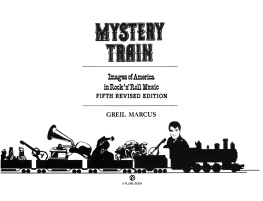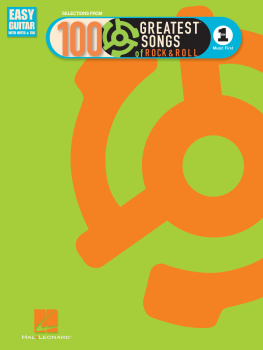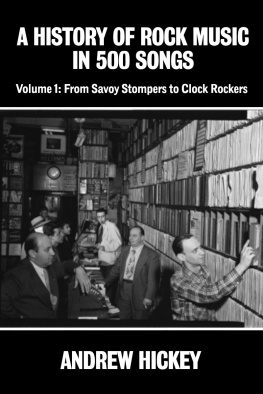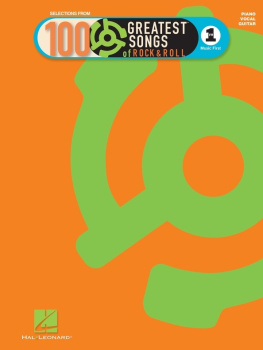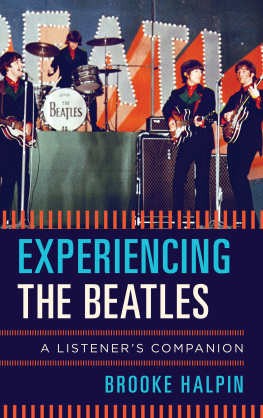The History of Rock n Roll in Ten Songs
Also by Greil Marcus
Mystery Train: Images of America in Rock n Roll Music (1975, 2008)
Lipstick Traces: A Secret History of the Twentieth Century (1989, 2009)
Dead Elvis: A Chronicle of a Cultural Obsession (1991)
In the Fascist Bathroom: Punk in Pop Music, 19771992 (1993, originally published as Ranters & Crowd Pleasers) The Dustbin of History (1995)
The Old, Weird America: The World of Bob Dylans Basement Tapes (2000, 2011, originally published as Invisible Republic, 1997)
Double Trouble: Bill Clinton and Elvis Presley in a Land of No Alternatives (2000)
The Manchurian Candidate (2002)
Like a Rolling Stone: Bob Dylan at the Crossroads (2005) The Shape of Things to Come: Prophecy and the American Voice (2006)
When That Rough God Goes Riding: Listening to Van Morrison (2010)
Bob Dylan by Greil Marcus, Writings 19682010 (2010)
The Doors: A Lifetime of Listening to Five Mean Years (2011)
AS EDITOR
Stranded (1979, 2007)
Psychotic Reactions & Carburetor Dung by Lester Bangs (1987) The Rose & the Briar: Death, Love and Liberty in the American Ballad (2004, with Sean Wilentz)
Best Music Writing 2009 (2009)
A New Literary History of America (2009, with Werner Sollors)
The History of Rock n Roll in Ten Songs
GREIL MARCUS

Published with assistance from the foundation established in memory of Calvin Chapin of the Class of 1788, Yale College.
Copyright 2014 by Greil Marcus.
Excerpt from It Wont Ring True, lyrics by Paul Muldoon, used by permission.
Excerpt from The Secret History of Rock & Roll from Charles Harper Webb, Liver, copyright the Board of Regents of the University of Wisconsin System. Reproduced courtesy of the University of Wisconsin Press.
Money Changes Everything. Words and music by Tom Gray. Copyright 1978 by Gray Matter Publishing and ATV Music. All rights administered by BMG Music.
Lost in America by Jon Langford. Copyright 2006 by Low Noise American Music (BMI). Used by permission. All rights reserved.
All rights reserved.
This book may not be reproduced, in whole or in part, including illustrations, in any form (beyond that copying permitted by Sections 107 and 108 of the U.S. Copyright Law and except by reviewers for the public press), without written permission from the publishers.
Yale University Press books may be purchased in quantity for educational, business, or promotional use. For information, please e-mail sales.press@yale.edu (U.S. office) or sales@yaleup.co.uk (U.K. Office).
Designed by Sonia Shannon.
Set in Electra type by Integrated Publishing Solutions.
Printed in the United States of America.
Library of Congress Cataloging-in-Publication Data
Marcus, Greil.
The history of rock n roll in ten songs / Greil Marcus.
pages cm
Includes bibliographical references and index.
ISBN 978-0-300-18737-3 (cloth : alk. paper) 1. Rock musicHistory and criticism. I. Title. II. Title: History of rock and roll in ten songs.
ML3534.M356 2014
782.4216609dc23
2013049423
A catalogue record for this book is available from the British Library.
This paper meets the requirements of ANSI/NISO Z39.48-1992 (Permanence of Paper).
10 9 8 7 6 5 4 3 2 1
To everyone I left out
Contents
Most of the recordings, live performances, and movie scenes mentioned in these pages can be found on YouTube.
But the life one leads cuts out all the lives one might have led; one is never a virgin twice; events engrave themselves. Life is a unity to the soul. We meet events halfway; they are part of us, and we are part of them; and nothing is incidental. Ahead comes the point where all events exist at once, and no new ones are in sight, the point on the edge of death, which is a reckoning point. It is the motion towards this that one tries to half by crying, Do you love me? Respect me? Will you always remember me?
MALCOLM BRADBURY, Eating People Is Wrong, 1959
The History of Rock n Roll in Ten Songs
A New Language
Allen Ruppersberg is a Los Angeles artist best known for his 1969 Als Caf, a restaurant where the functioning menu featured dishes composed entirely of locally scavenged objects, plates included, and for his 2003 transformation of Allen Ginsbergs Howl into a series of so-called singing posters. A few years ago, on a trip back to Cleveland, I went to the Rock and Roll Hall of Fame for the first time, he wrote in 2012. I found it fun enough, lots of memorabilia, film clips, old records, of course, and the now familiar story of RnR, told again in the basically familiar way.
That basically familiar way can be summed up by scrolling through the inductees to the Rock and Roll Hall of Fame, letting the names compose the history of the music, from the first classthe performers Chuck Berry, James Brown, Ray Charles, Sam Cooke, Fats Domino, the Everly Brothers, Buddy Holly, Jerry Lee Lewis, Little Richard, and Elvis Presley; as non-performers the 1950s disc jockey Alan Freed, the Sun Records producer Sam Phillips, and the record man John Hammond of Columbia; and as early influences the 1930s Mississippi blues singer Robert Johnson, the Father of Country Music Jimmie Rodgers, and the boogie woogie pianist Jimmy Yanceyon through the jazz pianist Jelly Roll Morton, the blues singers Ma Rainey and Bessie Smith, the jazz trumpeter Louis Armstrong, the gospel group the Soul Stirrers, the country singer Hank Williams, the folk singers Lead Belly, Woody Guthrie, and Pete Seeger, the nightclub vocal group the Ink Spots, the jazz singer Billie Holiday, the jump-blues bandleader Louis Jordan, the jazz guitarist Charlie Christian, the Los Angeles rhythm and blues bandleader and impresario Johnny Otis, the Western Swing band Bob Wills and His Texas Playboys, the R&B singers Dinah Washington and Charles Brown, the founding rock n roll vocal group the Orioles, the gospel singer Mahalia Jackson, the bluegrass bandleader Bill Monroe, the Texas blues guitarist T-Bone Walker, the jazz singer Nat King Cole, the record man Leonard Chess of Chess, the blues singer Muddy Waters, the harmonica player Little Walter, the songwriter Willie Dixon, the blues singer Howlin Wolf, the New Orleans record man Cosimo Matassa, the guitarist Les Paul, the guitar maker Leo Fender, John Lee Hooker, the blues singer Elmore James, Big Joe Turner, Clyde McPhatter and the Drifters, Bill Haley and the Comets, the songwriter Jesse Stone, the record men Ahmet and Nesuhi Ertegun, Paul Ackerman, Jerry Wexler, and Tom Dowd of Atlantic, Bo Diddley, the record man Milt Gabler of Decca, the New Orleans pianist Professor Longhair, the pianist Johnnie Johnson, the guitarist Scotty Moore, the bassist Bill Black, the drummer D. J. Fontana, the song-writer Otis Blackwell, the record man Syd Nathan of King, Jackie Wilson, the Platters, the New Orleans songwriter and bandleader Dave Bartholomew, the Coasters, the songwriters Jerry Leiber and Mike Stoller, the saxophonist King Curtis, Carl Perkins, LaVern Baker, Lloyd Price, the record man Art Rupe of Specialty, Roy Orbison, Ruth Brown, Gene Vincent and the Blue Caps, the rockabilly singer Wanda Jackson, Johnny Cash, Ricky Nelson, the guitarist and producer Chet Atkins, the guitarist James Burton, Jimmy Reed, the record man Ralph Bass, Little Willie John, the Moonglows, the Flamingos, Frankie Lymon and the Teenagers, the Dells, Eddie Cochran, Little Anthony and the Imperials, Dion, Hank Ballard, Bobby Darin, the promoter Dick Clark, the songwriter Doc Pomus, Ritchie Valens, the Impressions, Brenda Lee, the New Orleans songwriter and producer Allen Toussaint, the pianist Floyd Cramer, the New Orleans drummer Earl Palmer, the guitarist Freddie King, the Famous Flames, the Miracles, the record man Berry Gordy, Jr., of Motown, Bobby Blue Bland, the Isley Brothers, Duane Eddy, Etta James, Miles Davis, the producer Phil Spector, Gene Pitney, Darlene Love, the Ronettes, the drummer Hal Blaine, the songwriter Mort Shuman, the Ventures, the Shirelles, the Beach Boys, Buddy Guy, Del Shannon, the Aldon Music songwriters Carole King and Gerry Goffin, Ellie Greenwich and Jeff Barry, and Barry Mann and Cynthia Weil, the Aldon Music publisher Don Kirshner, Marvin Gaye, Bob Dylan, the Temptations, the Four Seasons, the Four Tops, the producers and song-writers Brian Holland, Lamont Dozier, and Eddie Holland of Motown, Stevie Wonder, Martha and the Vandellas, Solomon Burke, Ike and Tina Turner, the Beatles, the Beatles manager Brian Epstein, the producer George Martin, the Rolling Stones, the Rolling Stones manager Andrew Loog Oldham, the Dave Clark Five, the Righteous Brothers, the Supremes, the bassist James Jamerson and the drummer Benny Benjamin of Motowns Funk Brothers, the Lovin Spoonful, Dusty Springfield, the Byrds, the Who, the Hollies, the record man Lou Adler of Dunhill, Otis Redding, Sam and Dave, Booker T. and the M.G.s, the record man Jim Stewart of Stax-Volt, the Kinks, the Young Rascals, Van Morrison, Simon and Garfunkel, the Animals, Donovan, the Yardbirds, Jefferson Airplane, the Grateful Dead, Janis Joplin, the concert promoter Bill Graham, Aretha Franklin, B. B. King, the Doors, the record man Jac Holzman of Elektra, the Velvet Underground, Wilson Pickett, Percy Sledge, Bobby Womack, the record man Clive Davis of Columbia and Arista, Neil Diamond, Smokey Robinson, Albert King, Frank Zappa, Buffalo Springfield, Cream, Sly and the Family Stone, Curtis Mayfield, the Staple Singers, the Mamas and the Papas, the Jimi Hendrix Experience, Pink Floyd, the Small Faces, Creedence Clearwater Revival, Leonard Cohen, Fleetwood Mac, the Bee Gees, Dr. John, Santana, Jann Wenner of
Next page

